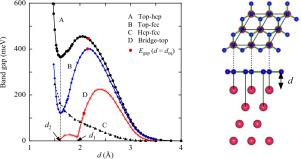当前位置:
X-MOL 学术
›
Surf. Sci.
›
论文详情
Our official English website, www.x-mol.net, welcomes your
feedback! (Note: you will need to create a separate account there.)
Hybridization versus Sublattice Symmetry Breaking in the Band Gap Opening in Graphene on Ni(111): A First-Principles Study
Surface Science ( IF 2.1 ) Pub Date : 2020-10-01 , DOI: 10.1016/j.susc.2020.121651 Kazume Nishidate , Satoru Tanibayashi , Michiaki Matsukawa , Masayuki Hasegawa
Surface Science ( IF 2.1 ) Pub Date : 2020-10-01 , DOI: 10.1016/j.susc.2020.121651 Kazume Nishidate , Satoru Tanibayashi , Michiaki Matsukawa , Masayuki Hasegawa

|
Abstract Band gap opening in graphene (Gr) on metals has been ascribed to hybridization, sublattice symmetry breaking (SSB), or conbinations of both. However, how and to what extent band gap opens under the influence of these effects is not well understood and is still a question in controversy. In this paper, we use first-principle calculations to elucidate this controversy by focusing on Gr/Ni(111), which provides an ideal platform for the present study owing to a (1 × 1)-commensurate structure resulting from negligible lattice mismatch. Electronic structures of artificially expanded or compressed systems with larger and smaller Gr-Ni(111) separations (d) than the equilibrium one (deq) are interpolated to find characteristics of band gap opening in Gr/Ni(111) with d ≈ deq. Similarities and differences among the top-hcp, top-fcc and bridge-top structures are also fully utilized in the analyses based on an additive model. We find that the band gap in Gr in the brigde-top structure is rather small, which can be explained by the absence of SSB in this structure. On the other hand, band gaps in Gr are much larger in the top-hcp and top-fcc structures, in which SSB is the strongest among possible structures. We have successfully discriminated, for the first time, the effects of hybridization and SSB on the band gap opening in these structures from each other and found that both effects are comparable for d ≈ deq and together induce band gaps of ~ 400meV, which are about four times as large as that in the bridge-top structure. These results provide a clear understanding of the band gap opening in Gr/Ni(111) and, though not directly applicable, would provide a useful insight into the band gap opening in other Gr/metal superstructures resulting from lattice mismatch, intercalation, or other modifications.
中文翻译:

Ni(111) 上石墨烯带隙开口中的杂化与亚晶格对称性破坏:第一性原理研究
摘要 金属上石墨烯 (Gr) 的带隙打开归因于杂化、亚晶格对称性破坏 (SSB) 或两者的结合。然而,在这些效应的影响下,带隙是如何以及在多大程度上打开的还不是很清楚,仍然是一个有争议的问题。在本文中,我们使用第一性原理计算通过关注 Gr/Ni(111) 来阐明这一争议,由于可忽略不计的晶格失配导致 (1 × 1) 相称结构,这为本研究提供了理想的平台。对具有比平衡一 (deq) 更大和更小的 Gr-Ni(111) 间距 (d) 的人工扩展或压缩系统的电子结构进行插值,以找到 Gr/Ni(111) 中带隙开口的特性,d ≈ deq。top-hcp 之间的异同,在基于加性模型的分析中也充分利用了顶部 fcc 和桥顶结构。我们发现桥顶结构中 Gr 的带隙相当小,这可以通过该结构中没有 SSB 来解释。另一方面,top-hcp 和 top-fcc 结构中 Gr 的带隙要大得多,其中 SSB 是可能结构中最强的。我们第一次成功地区分了杂交和 SSB 对这些结构中带隙开放的影响,并发现这两种影响在 d ≈ deq 方面是可比的,并且共同诱导了约 400meV 的带隙,约为是桥顶结构的四倍。这些结果提供了对 Gr/Ni(111) 带隙开口的清晰理解,虽然不能直接适用,
更新日期:2020-10-01
中文翻译:

Ni(111) 上石墨烯带隙开口中的杂化与亚晶格对称性破坏:第一性原理研究
摘要 金属上石墨烯 (Gr) 的带隙打开归因于杂化、亚晶格对称性破坏 (SSB) 或两者的结合。然而,在这些效应的影响下,带隙是如何以及在多大程度上打开的还不是很清楚,仍然是一个有争议的问题。在本文中,我们使用第一性原理计算通过关注 Gr/Ni(111) 来阐明这一争议,由于可忽略不计的晶格失配导致 (1 × 1) 相称结构,这为本研究提供了理想的平台。对具有比平衡一 (deq) 更大和更小的 Gr-Ni(111) 间距 (d) 的人工扩展或压缩系统的电子结构进行插值,以找到 Gr/Ni(111) 中带隙开口的特性,d ≈ deq。top-hcp 之间的异同,在基于加性模型的分析中也充分利用了顶部 fcc 和桥顶结构。我们发现桥顶结构中 Gr 的带隙相当小,这可以通过该结构中没有 SSB 来解释。另一方面,top-hcp 和 top-fcc 结构中 Gr 的带隙要大得多,其中 SSB 是可能结构中最强的。我们第一次成功地区分了杂交和 SSB 对这些结构中带隙开放的影响,并发现这两种影响在 d ≈ deq 方面是可比的,并且共同诱导了约 400meV 的带隙,约为是桥顶结构的四倍。这些结果提供了对 Gr/Ni(111) 带隙开口的清晰理解,虽然不能直接适用,











































 京公网安备 11010802027423号
京公网安备 11010802027423号